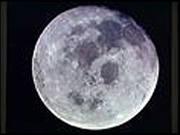 |
| View of the moon - Lunik II is supposed to hit close to the Sea of Tranquillity |
|
1959: Soviets launch rocket at the moon
|
Artificially 1969: FilmTheTheAA A massive Russian rocket, carrying 860lb (391kg) of scientific instruments, has been successfully launched at the moon.
Latest reports say the rocket, Lunik II, is on course to reach its destination at 2201BST tomorrow.
This is the second rocket launched by Russia towards the moon. The first was on 2 January. It missed its target and continued out into space.
A multistage rocket was used for the launch, which had to achieve a speed of seven miles per second (11.3km) to escape the earth's gravitational pull.
Lunik II is carrying equipment to measure, among other things, the magnetic fields of the earth and the moon and the belts of radiation surrounding the earth.
The craft's journey was briefly visible from earth at 1940 BST this evening when it emitted a bright yellow sodium cloud intended to look like an artificial comet.
Although skies were overcast in Moscow, at least two Russian observatories in the Caucasus and in Uzbekistan in Central Asia were able to photograph the cloud.
The flare was also visible at Leiston in Suffolk.
The Soviet leader, Nikita Khruschev is due in Washington on Tuesday. There is speculation this latest lunar expedition has been deliberately timed to coincide with the trip.
The scientific instruments have been contained in a gas-filled sphere on the front of the craft. It has been hermetically sealed to prevent any of the contents contaminating the moon's atmosphere.
Moscow scientists say the actual landing 236,875 miles (381,131km) away cannot possibly be seen from earth but the break-off in radio transmission will indicate the craft has arrived at its destination.
The landing is meant to take place among the three large depressions on the moon's surface, known as the seas of Serenity, Tranquillity and Vapours.
|